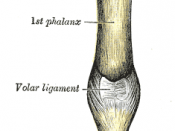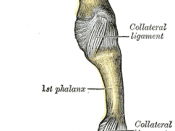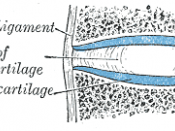The metacarpophalangeal joint is known by most people as the "knuckle". The term metacarpophalangeal can be broken down into two separate anatomical terms, the metacarpal and the phalanges. Metacarpals are located in the middle of the hand distal to the carpal bones and phalanges are the bones that make up your fingers. Thus, the metacarpophalangeal joint is the articulation where both the metacarpals and phalanges meet. There are five of these joints located within each hand, and the metacarpophalangeal (MCP) joint located in the thumb has a different anatomical structure than that of the other four. The metacarpophalangeal joint may seem simple but is a complex part of the body which is essential to the hand.
Like stated earlier the MCP joint is the articulation between the metacarpals and phalanges. The MCP joints are a condylar joint that is formed by the reception of the round heads of the metacarpals into shallow cavities at the proximal ends of the first phalanges.
The thumb is an exception and resembles more of a ginglymoid joint. (4) A condylar joint, also known as ellipsoidal, is defined as a joint that allows all types of movement aside from pivotal movements. A ginglymoid joint; however, allows movement along only one plane, and is also known as a hinge joint. (7)
Each one of the MCP joints contains 3 ligaments, which is a piece of fibrous connective tissue which connects two bones together or connects two different parts of a bone. (2) Two of these ligaments within the MCP joint are known as collateral ligaments and the other is referred to as a palmar ligaments or volar plates. Palmar ligaments differ from most ligaments in that they are thick, dense, and fibrocartilaginous. They are also located between the collateral ligaments and are connected to...


